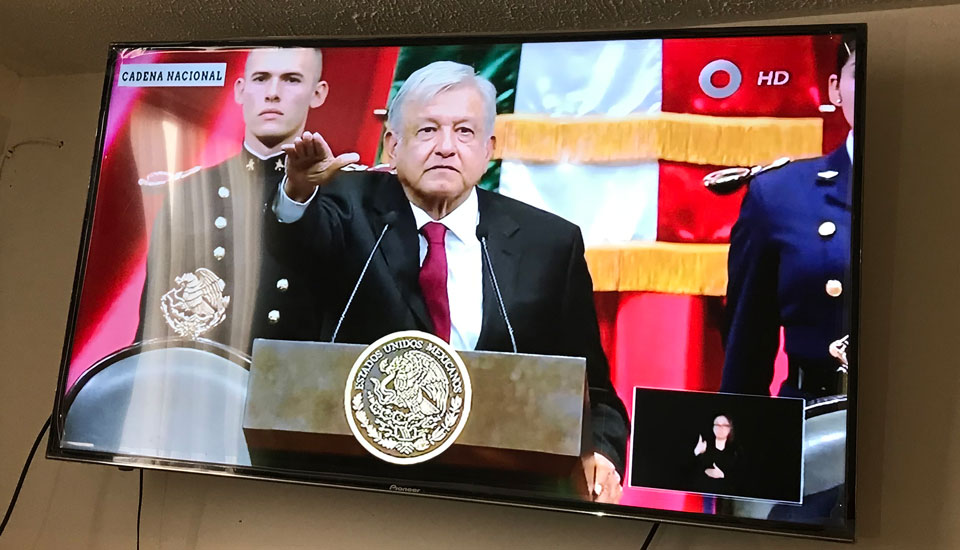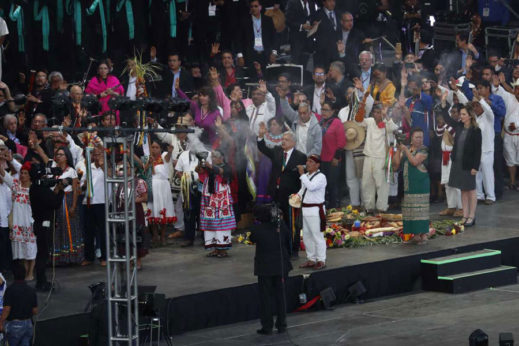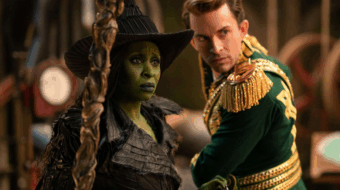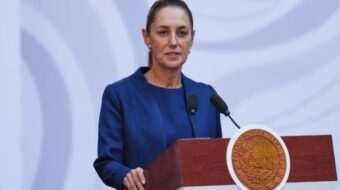
ZACATECAS, MEXICO—With ceremonial dignity both traditional and novel, 65-year-old Andrés Manuel López Obrador, Morena candidate who won the election by a commanding margin after two previous attempts—both times marred by widespread accusations of fraud—took the reins of the 57th presidency of Mexico on Saturday, December 1.
The July 1 elections for president and legislative offices around the country yielded impressive Morena majorities in both houses of Congress and in most states. Known familiarly by his initials, AMLO will serve for six years and under Mexican law is not eligible for reelection.
Morena is an acronym for the Movimiento Regeneración Nacional, or National Regeneration Movement, a bloc of various left-of-center parties. Significantly, the word “morena” (in its feminine form) means tanned or dark or brown, suggesting the lifting up of people of color and women. The movement has a very strong women’s empowerment platform.
Inauguration Day proceedings were televised nationally.
Sí se pudo—Yes, we could!
The main installation ceremony took place in the Cámara de Diputados—the Chamber of Deputies—corresponding to the U.S. House of Representatives, in the national capital of Mexico City. As in the U.S., Mexico also has a senate. Preparing for the president-elect’s arrival, members of different political parties gave solemn speeches marking the significance of the day and the transfer of power.
The manner of AMLO’s arrival itself was full of meaning. When he tried to leave his house that morning, it was surrounded by a throng of well-wishers he could barely move through. Eventually, but already behind schedule, he entered a modest white Volkswagen Jetta, rejecting the pomp and elegance of a limousine, and joined the convoy of press and official cars and motorcycles through the city to the seat of government. Television cameras tracked his passage through the streets, which were lined with Mexican citizens waiting to catch a glimpse of the new president, snapping photographs with their mobile phones, and reaching out to touch or momentarily grasp AMLO’s outstretched hand through the back window. Some thrust bouquets of flowers through the window. The open-handed gesture, repeated all along the route, symbolized a new era of access to government, a genuinely radical populism.
At the same time, the outgoing President Enrique Peña Nieto, wearing his ceremonial sash of office across his right shoulder, was shown arriving with his entourage in generously proportioned black limousines.
Newscasters showed scenes from an event that took place the day before, the granting of Mexico’s Order of the Aztec Eagle, the nation’s highest honor awarded to foreigners (which had been given to Nelson Mandela), to Jared Kushner, Donald Trump’s son-in-law and close adviser, reputedly for having done so much for the country in renegotiating the NAFTA treaty. Responses to that award that I heard from various Mexicans over the next few days seemed to coalesce around the suspicion that the still young Peña Nieto was likely feathering his own nest anticipating future deals with American business leaders such as Trump. The move was highly controversial.
AMLO’s entry into the hall went slowly, as legislators jammed his passageway, offering handshakes, abrazos, and pats on the back. Members of the media and other legislators seated farther away clicked and flashed away trying to capture that perfect shot of this defining moment in the country’s history.
Cameras panned through the crowd of invited guests, among whom U.S. Vice President Mike Pence and First Daughter Ivanka Trump could be seen, along with Cuba’s Miguel Díaz-Canel, and Bolivia’s Evo Morales. Above the stage the words “La patria es primero”—the nation comes first—gave silent benediction to the unfolding ritual.
López Obrador recited the oath of office with his right hand raised as a sign of loyalty to the country. Then Peña Nieto, seated on the dais with other officials, rose to remove the presidential tricolor sash and place it on his successor’s shoulders. The audience chanted “Sí se pudo”—Yes, we could!
AMLO’s inaugural address began auspiciously with gracious thanks to Peña Nieto who, unlike other presidents in Mexican history, did not personally insert himself into the electoral process and respected the will of the people.
But then AMLO got down to business, defining the present crisis and proposing his solutions. His government, he said, would be the Fourth Transformation in Mexican history—the other three being national Independence, which also eliminated slavery, the Reforma of radical Indigenous President Benito Juárez in the mid-19th century, and the Mexican Revolution of 1910-17 that overthrew the despotic rule of dictator Porfirio Díaz and instituted new norms of justice and democracy.
Promising a new government that would be peaceful, orderly, profound and radical, AMLO committed himself to rooting out corruption and impunity, which have impeded the nation’s progress.
The new president got very specific: “The neoliberal model failed.” Characterized by dishonesty in government, and both public and private corruption, it is the source of gross economic and social inequality. Unlike any other time in modern Mexican history since the 1930s, the neoliberal period, beginning in 1983, has been the most inefficient, with concentration of wealth, an enormous wave of emigration and an explosion of anti-social behavior. In short, a “disaster and calamity” for the country, where four out of ten Mexicans live in poverty.
Economically, the energy “reform” that Peña Nieto passed has resulted in less production of oil and the failure to build new refineries, importation of half the nation’s consumption of the staple corn, a minimum wage that is among the lowest on Earth, and 24 million Mexican citizens who have chosen, or been forced to emigrate. “Neoliberalism is corruption,” AMLO pronounced without evasion, a robbery and sell-off of the national treasure.
López Obrador plans to regenerate the public life of the nation with honest government from top to bottom. As promised in his campaign, “it is more important to plan for the future than punish the wrongdoers of the past.” “We don’t have enough jails, and we do not want to subject Mexico to conflict and fracture.” “There will be no persecutions” (loud protests from Morena deputies in the audience, crying “Queremos justicia”—We want justice).
Almost as if anticipating that reaction, AMLO proceeded to announce the establishment of a Truth Commission to determine what happened to the 42 students kidnapped and “disappeared” from the Ayotzinapa Rural Teachers College in 2014, and punish those responsible.
In his term, AMLO said, the citizenry will have the last word and will be consulted on everything. He swore there would be no abuse of the public trust by himself, his wife or children, and that they would be judged like any other citizen. “Government will not facilitate the sacking of wealth, nor defend a rapacious minority.”
Electoral fraud would end. Elections will be clean and free, with no more buying of votes.
His administration would protect minorities, including sexual minorities, Indigenous peoples and the poor, as well as nonbelievers and people of all faith traditions. He continues to use his campaign slogan, “For the good of all, the poor first.”
Taxes will not be raised, and the price of food will not go up, but Mexico will not go into debt, such is the enormity of savings he anticipates with corruption eliminated. At the same time, contracts will be honored, and investors are welcome in a spirit of confidence and trust.
Special attention will be given to the Mexican South and Southeast, underdeveloped areas from which a large percentage of emigrants, many from Indigenous cultures, has come. Emigration will become optional, not obligatory. A new train route will be built in that region to facilitate local residents to move about in search of work, and to open those states to tourism in one of the richest archeological arenas in the world.
In the North, AMLO proposes a 25-kilometer-wide free trade zone below the U.S.-Mexican border all the way from West to East which will help combat poverty and marginalization in rural areas, but keep Mexican citizens in Mexico. “We will not condemn to poverty those born in poverty.”
He promised a doubling of the senior benefit, and an equivalent benefit for disabled Mexicans. He also embraced pro-environmental policies, including no fracking, so that in the drive to modernize nothing of the natural biodiversity of Mexico will be sacrificed.
AMLO looks forward to an “austerity” government, but not the kind pushed by neoliberalism. His austerity would terminate the exorbitant privileges of the high bureaucracy, and make Mexico’s government “middle class.” At the same time, salaries at the lowest-paid rungs of government employment—“los de abajo” (the people on the bottom)—will be raised. He has sworn to sell off the presidential plane, and limit Mexico’s foreign profile to the necessary minimum of embassies and consulates.
He has reduced his own pay to 40 percent of the previous salary, and has canceled the extremely generous retirement packages accorded to former presidents. In addition, he has declined to live in Los Pinos, the presidential palace, and that morning opened the premises to the general public as a new museum. Later breaks in the televised programming showed lines of visitors eagerly peeking in on the “lives of the rich and famous” in the palace and grounds that are 13 times the size of the White House. “I am not interested in the paraphernalia of power, only in service,” the new president says.
AMLO could not ignore the issues of drugs and violence that have plagued the country in recent decades. He emphasized new ways of understanding the causes of anti-social behavior and taking new approaches on the part of the police. “The president of Mexico,” he vowed, “will never give an order to repress Mexican people or suppress human rights.”
López Obrador recalled earlier friends and comrades from the “many hard years of personal and collective struggle,” and recalled what some of them used to tell him: “You do not have the right to fail your people.”
Before he concluded, he mentioned by name and office the many officials from abroad who had come to witness this historic transition, including King Felipe VI of Spain and UK Labour Party leader Jeremy Corbyn. He said he had received a message of congratulation from President Trump. Venezuela’s Nicolás Maduro was not present for the speech—he arrived later in the day, and perhaps he purposely stayed away to avoid becoming a lightning rod—but some right-wing lawmakers from PAN (National Action Party) were already prepared with a protest banner they paraded in front of the new president saying that Maduro was not welcome. AMLO’s mandate is broad, with a recent poll giving him a 66 percent approval rating (compared to 70 percent disapproval for Peña Nieto), but clearly not unanimous.
AMLO declared himself an optimist. This “tenacious, hard-working, struggling people…will confront our problems and come out well because we will respect our culture as our savior. We have survived all kinds of calamities and re-emerged with our dignity.” He promised “a modern country, more just, democratic, fraternal and happy.”
Not only did he reaffirm the traditional policy of no re-election in Mexico. He ended saying that in two and a half years he would hold a national referendum on his tenure and accomplishments so far, to see if the citizens of Mexico wanted to keep him in office or not, and if not, he would leave without resistance. “The people are in charge.”
With that inaugural speech, delivered with an unfaltering voice and never once interrupted for a sip of water, Andrés Manuel López Obrador was clearly not speaking only to his nation, but to the world. His bristling, unvarnished challenge to neoliberalism, with his predecessor Peña Nieto sitting sullen-faced just a few feet away from him on the stage, served as a message not only to the rest of the underdeveloped world but to the industrialized world as well, laying out not simply rhetorical possibilities for a better life. He was not content to smooth the transition as the innocuous building upon the achievements of his predecessors. Rather he signaled a profound rupture with the destructive habits of the past. He positioned himself as the new leader of what was once called the “Third World,” promising to raise Mexico as Luiz Inácio Lula da Silva lifted up the poor and middle classes of Brazil. If he achieves even a portion of his ambitious “good government” program, he could join the ranks of great Latin American reformers such as Lázaro Cárdenas, Fidel Castro, Hugo Chávez, Salvador Allende, Evo Morales and José Mujica.
Indigenous purification and investiture
Television cameras again followed the new president’s convoy to the block-long Palacio Nacional, occupying one side of central Mexico City’s immense Zócalo, the vast square in front of the main Cathedral of the nation. He entered a portal reserved exclusively for the president of the country, and inside saluted the flag to the accompaniment of a small military band, preparing himself to appear on a stage in the Zócalo for another ceremony later that afternoon, never before seen in Mexico, and indeed rarely in the Americas: He and his wife, Beatriz Gutiérrez, would be blessed by a gathering of Indigenous shamans from diverse communities of Mexico and handed the bastón de mando, the staff of command.
A five-story-tall stage had been erected in front of the Cathedral, blocking the view of much of its façade, only its tall towers seen rising behind it. Crowds gradually entered the Zócalo until, by the time the ceremony was to begin, it was packed. Many in the happy throng carried umbrellas against a strong, bright sun. AMLO made his entrance through a passageway from the Palacio to the stage, again shaking hands, posing for photos, autographing papers thrust before him, and accepting flowers, messages and appeals from the attendees lining his walkway.
The importance of the Zócalo can hardly be overstated in Mexican history. This grand urban plaza was the ceremonial center of pre-Conquest Tenochtitlán, the Aztec capital, and its temple occupied the location where the Cathedral now stands. In fact, the Cathedral was built in part using stones from the Aztec temple as a symbol of the destruction of paganism and the imposition of the new Catholic religion. Such practice was common in Conquest mentality: Use the familiar sanctity of place to attract Indigenous people to the new faith.
Thus, to hold a “limpia,” a cleansing or purification ceremony on that spot, complete with burning herbs and Indigenous chanting and costuming, represented a virtual repudiation of European religion. It could be seen as a “Reconquista,” a re-conquest such as the Catholics celebrated when they expelled the Moors and the Jews from Spain and converted mosques and synagogues into churches. Now, the Zócalo belonged once again to the Mexican people.

Media made much, also, of the dinner following the ceremony for visiting dignitaries (Nicolás Maduro had arrived by now) in the Palacio Nacional, featuring a menu of 100 percent native Mexican dishes.
One of the signature features of AMLO’s campaign is that he visited every state in the country (perhaps he took an object lesson from Hillary Clinton!), but not just for rallies in the capital cities. He went to small towns and villages, introducing himself as someone concerned with everyday people’s problems, especially in the rural sector, which no candidate had ever done before. The “people’s inauguration” before a crowd of at least 50,000 in the Zócalo was therefore not just the culmination of this approach but in many people’s minds—those not able to attend the formalities in the Chamber of Deputies—the truer transfer of authority. No previous presidential inauguration had ever highlighted Indigenous culture, religion and participation. Effectively, for most of recent Mexican history, Indigenous peoples had been largely ignored.
The backdrop on the stage, rising some five stories high, appeared to a television viewer like a projection of a native textile design. It was such a design, but it was not a projection: It had been handcrafted by Mayan artisans out of woven colored corn leaves.
The ceremony itself lasted almost an hour. Native leaders from different cultures “smudged” the president and his wife with burning herbs. Dancers and celebrants acknowledged the spirits of the four corners, the elements, and the ancestors. Conches were blown. The full participation of women was especially notable. The theme of the day was “purification,” as if the presidency itself needed a good solid scrubbing after centuries of privilege, oppression and exploitation. Sanctified cloths and necklaces of corn were laid on the new president. He was handed a white wooden cross decorated with native flowers, symbolizing the religious syncretism which characterizes much of the content of faith in Latin America. (At first I thought that was the bastón de mando and felt momentarily somewhat disappointed by the reversion to Christian symbology, but I was soon proved wrong.)
A display of native fruits and vegetables on stage, a kind of Mexican cornucopia, represented not just the bounty of the land, but the potential that with AMLO’s policies it would be possible once again for Mexicans to actually prosper nutritiously on their own land.
Finally, the shamans offered AMLO the bastón, a hand-carved wooden stick about a yard long, decorated with ribbons and carvings. As the ceremonial participants left the stage or reorganized themselves in cadres behind him, AMLO chatted amiably with all who approached him with their greetings, wishes and abrazos. Having planned this event as the principal outreach to the people on Inauguration Day, AMLO was the model of respect and honor accepting the blessings of Indigenous Mexico. At no time did he ever appear distracted or disinterested or treating this solemn hour with perfunctory attention.
Then, still draped in Native garments, he launched into his speech, which on many points recapitulated the themes he had addressed earlier before the deputies and invited guests. Here, however, he focused less on the analysis of neoliberalism, and more on his commitment to the poor and marginalized. He expanded on his plan to establish 100 public universities, support artists, science and technology, provide immediate healthcare to the poorest in the country and work quickly to create a first-class healthcare system for all of Mexico comparable to Canada and the Nordic countries (he advisedly skipped mention of his immediate neighbor to the north).
He also spoke of building roads into isolated communities, and improving conditions for tuna and sardine fishing. “We are going to rescue the major industries for the Mexican people.” Port improvements on both the Caribbean and the Pacific sides of the Isthmus of Tehuantepec and a modern internal highway between them will facilitate international commercial activity. He talked of connecting the entire country to free internet service. And he repeated his commitment to the mid-term referendum on his presidency.
The year 2019 marks the centennial of the assassination of revolutionary leader Emiliano Zapata, and in recognition of him AMLO said that all government offices will prominently feature his slogan “Tierra y Libertad”—Land and Liberty—as a reminder of the ideals yet to be achieved. He quoted Zapata as his own guiding principle: “Con el pueblo todo, sin el pueblo nada”—With the people everything, without the people nothing.
Again, AMLO delivered his speech without ever reaching for a drink of water, his clarion call still strong at the end. Perhaps even more remarkably, as he delivered his hour-long speech, he gestured demonstrably with his right hand but in his left hand he never let go his firm grasp of the Indigenous bastón de mando, the symbol of his voice and authority, which another politician might well have earlier handed over to an aide. One could only believe that he considered his base of support in the Indigenous community fully the equal, and maybe superior, to his popularity in intellectual and political sectors.
Finally, quite remarkably, but fully in line with historic anti-clerical traditions of the Mexican Revolution, apart from the white wooden cross the Indigenous leaders gave him, there was no other Christian imagery or speech throughout the day—no ministers of faith, bishops or cardinals asking for benediction from Jesus or God.
The new era begins
Widely reported were cordial messages and telephone calls between López Obrador and Donald Trump. Clearly AMLO does not wish to unnecessarily antagonize his North American counterpart, but perhaps there is a bit of “Mexico First” in his outlook that Trump could relate to. And if AMLO’s policies do mitigate the need for Mexicans to emigrate for a better life, that might assuage one of Trump’s foundational sore points. Other than that, however, as Mexico asserts its economic independence, the two nations are bound to clash as the two competing visions for prosperity collide on virtually every other front. Trump has not appointed a new ambassador to Mexico since Roberta Jacobson retired in May. The person he eventually does nominate may indicate the direction in which he wants to take U.S.-Mexican relations.
In the aftermath of the inaugural speeches, on Dec. 5, right-wing protests broke out in Mexico City against AMLO. Demonstrators claimed he would turn Mexico into another Venezuela, shouting, “Amigo de Maduro, dictador seguro”—Any friend of Maduro will be a dictator for sure. My host in Zacatecas also speculated that out of fear of regulation, higher corporate taxes and the elimination of perks and privileges, Mexico might well soon experience a flight of capital to safe havens such as Miami, Panama or the Cayman Islands.
Yet overall, the buzz in this state capital city, as surely elsewhere in Mexico, was full of contained excitement for the future. AMLO’s broad promises were received with a general attitude of “Pues, vamos a ver”—Well, let’s see; earnest hope moderated by memories of decades of politicians campaigning in poetry, governing in prose. The conversations I heard can be summed up in this one exchange:
“The picture he’s painting is a Garden of Eden for Mexico.”
“But it could be done.”










